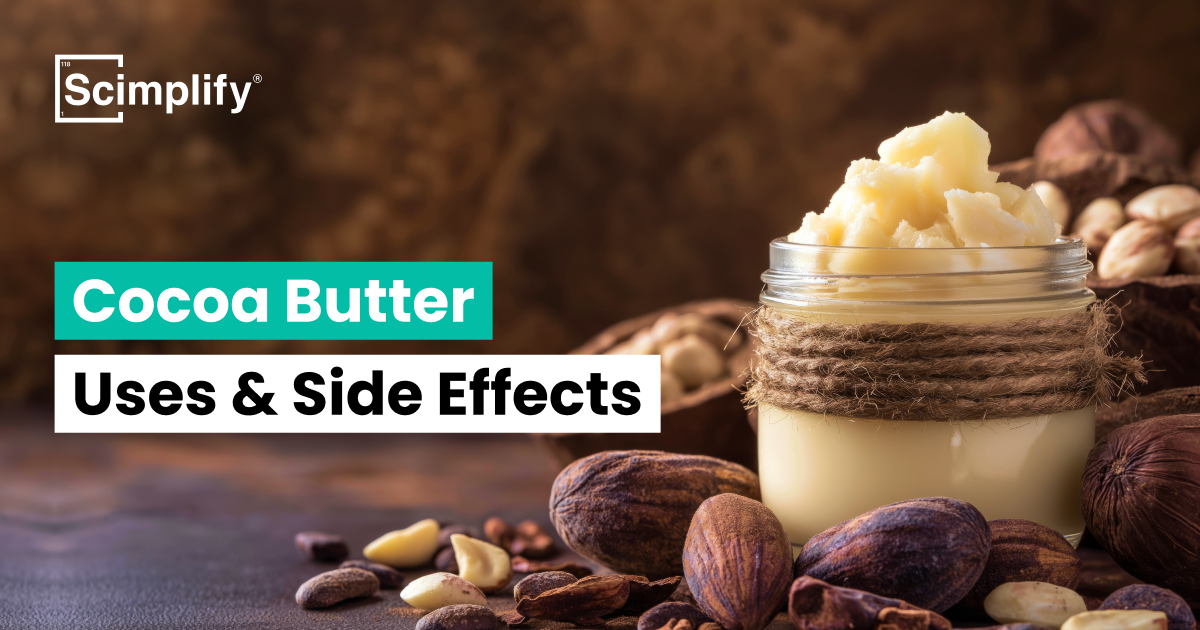Cocoa Butter - Uses and Side Effects
Cocoa butter is a natural fat used in chocolate, skincare, and cooking. Benefits skin hydration; side effects include acne, weight gain, and spoilage.

Cocoa butter is a natural fat extracted from cocoa beans, which are mainly triglycerides composed of palmitic, stearic, and oleic acids. Its molecular formula is complicated due to the many combinations of triglycerides, but it tends to be enriched with symmetrical monounsaturated triacylglycerols, which have a significant impact on its melting properties and texture.
With a melting point close to human body temperature (35–37 °C), it imparts a melt-in-the-mouth feature to the product, rendering it invaluable in confectionery and cocoa butter moisturizer items. The chemical and physical properties of cocoa butter allow it to find a wide variety of applications in the food, pharmaceutical, and personal care industries.
As a trusted supplier and distributor of Cocoa butter, Scimplify also provides high-quality products in large quantities to meet the needs of clinics and pharmaceutical firms worldwide.
Cocoa Butter Uses
1.Chocolate and Confectionery
- Provides smooth texture, gloss, and melting profile in chocolates.
- Ensures firmness and shelf stability for dark cocoa butter and milk chocolates.
- Used in unsweetened cocoa butter coatings and as a carrier fat in flavor encapsulation.
2.Cosmetics and Personal Care
- Acts as a natural emollient and cocoa butter moisturizer.
- Softens skin, improves elasticity, and protects against dryness.
- Found in lotions, lip balms, creams, and hair care products.
3.Pharmaceuticals
- Serves as a base in ointments and suppositories.
- Its melting profile supports controlled release and easy application.
4.Food Industry
- Adds creaminess and pleasant mouthfeel in bakery items and desserts.
- In bulk cocoa butter supply, it supports large-scale production for confectionery and nutraceuticals.
- Increasing use of cocoa butter for cooking in plant-based and vegan recipes.
Experience Premium Cocoa Butter - Request Your Sample Today!
Side Effects of Cocoa Butter
While cocoa butter is generally recognized as safe, there are a few important considerations:
1.Allergic Reactions
- Rare cases of skin rashes or irritation.
- Digestive discomfort in those sensitive to cocoa products.
2.Skin Concerns
- Heavy, oily texture may clog pores.
- Can trigger acne in oily or sensitive skin types.
3.Weight & Calories
- Cocoa butter for cooking is high in calories.
- Overuse may contribute to weight gain if consumed excessively.
4.Oxidation & Storage
- Raw cocoa butter is prone to rancidity when exposed to heat, light, or air.
- Requires airtight packaging and cool, dry storage to retain quality.
5.Digestive Issues
- Overconsumption may cause bloating or mild stomach upset.
- Environmental Impact
- Naturally biodegradable and eco-friendly.
However, large-scale cocoa farming raises sustainability concerns.
Conclusion
The composition of cocoa butter, its multifunctional nature, and smooth texture are the attributes that render this raw material irreplaceable. It lies between indulgence and wellness, as cocoa butter is both consumed in chocolate manufacture and used for the skin as a natural moisturizer.
Despite minor side effects of cocoa butter, its use in food, drugs, and cosmetics produces an important commodity in the world. On the large scale, bulk cocoa butter can offer consistency to manufacturers and consumers in every application, such as skincare and cooking.
Quality assurance, storage, and sustainable sourcing will be used to position cocoa butter to retain the innovation, product excellence, and consumer trust within the world.


